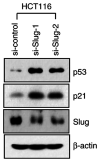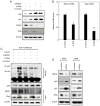Slug promotes p53 and p21 protein degradation by inducing Mdm2 expression in HCT116 colon cancer cells
- PMID: 34345306
- PMCID: PMC8323001
- DOI: 10.3892/ol.2021.12942
Slug promotes p53 and p21 protein degradation by inducing Mdm2 expression in HCT116 colon cancer cells
Abstract
Our previous study revealed that the tumor suppressor/transcription factor p53 directly binds to its transcriptional target, p21, and that the p53/p21 complex binds to zinc finger protein SNAI2 (Slug), a tumor promoter/transcription factor; thereby promoting the degradation of Slug by Mdm2, an E3 ligase. The present study demonstrated that Slug reduced the cellular expression levels of p53 and p21 in HCT116 colon cancer by decreasing their protein stability. In parallel, Slug increased the mRNA and protein expression levels of Mdm2 in these cells. Moreover, knockdown of Mdm2 using specific small interfering RNAs abolished the ability of Slug to induce the degradation of p53 and p21. Considering the well-known function of Mdm2 in facilitating p53 and p21 degradation, these data suggested that Slug promoted p53 and p21 degradation by inducing Mdm2 expression. Moreover, Slug increased ubiquitination levels of p53 in HCT116 cells. This is consistent with the fact that Mdm2 induces p53 degradation by ubiquitinating p53, and further confirmed that Mdm2 acted downstream of Slug. Comparative studies using HCT116 cells and their p53- or p21-knockout variants have revealed that Slug requires p21 to induce p53 degradation. This result is consistent with our previous study, which revealed that Mdm2 acts more efficiently on p53 in the p53/p21 complex compared with on p53 alone. By contrast, Slug did not require p53 to induce p21 degradation, suggesting that p53 was dispensable in Mdm2-mediated p21 degradation. Notably, the ability of Slug to increase/decrease Mdm2/p53 and p21 levels, respectively, was not confined to HCT116 cells alone, but was also confirmed in A549 and H460 lung cancer cells. Collectively, the results of the present study suggested that Slug could counter p53 and p21. The balance between these two opposing groups (Slug vs. p53/p21) may depend on environmental stresses and the internal physiology of cells.
Keywords: Mdm2; oncogene; p21; p53; protein stability; tumor suppressor; zinc finger protein SNAI2.
Copyright: © Kim et al.
Conflict of interest statement
The authors declare that they have no competing interests.
Figures





Similar articles
-
DDX3 loss by p53 inactivation promotes tumor malignancy via the MDM2/Slug/E-cadherin pathway and poor patient outcome in non-small-cell lung cancer.Oncogene. 2014 Mar 20;33(12):1515-26. doi: 10.1038/onc.2013.107. Epub 2013 Apr 15. Oncogene. 2014. PMID: 23584477
-
p53 controls cancer cell invasion by inducing the MDM2-mediated degradation of Slug.Nat Cell Biol. 2009 Jun;11(6):694-704. doi: 10.1038/ncb1875. Epub 2009 May 17. Nat Cell Biol. 2009. PMID: 19448627
-
Cooperative actions of p21WAF1 and p53 induce Slug protein degradation and suppress cell invasion.EMBO Rep. 2014 Oct;15(10):1062-8. doi: 10.15252/embr.201438587. Epub 2014 Aug 20. EMBO Rep. 2014. PMID: 25141863 Free PMC article.
-
Stabilization of P/CAF, as a ubiquitin ligase toward MDM2, suppresses mitotic cell death through p53-p21 activation in HCT116 cells with SIRT2 suppression.Biochem Biophys Res Commun. 2019 Jan 1;508(1):230-236. doi: 10.1016/j.bbrc.2018.11.136. Epub 2018 Nov 24. Biochem Biophys Res Commun. 2019. PMID: 30482390
-
Escape, or Vanish: Control the Fate of p53 through MDM2-Mediated Ubiquitination.Anticancer Agents Med Chem. 2015;16(2):174-89. doi: 10.2174/1871520615666150907093358. Anticancer Agents Med Chem. 2015. PMID: 26343143 Review.
Cited by
-
P53/MDM2 Complex-Based Targeted Strategies in Colon Adenocarcinoma.Acta Med Acad. 2023 Apr;52(1):24-29. doi: 10.5644/ama2006-124.398. Acta Med Acad. 2023. PMID: 37326394 Free PMC article.
-
Zinc Finger Proteins: Functions and Mechanisms in Colon Cancer.Cancers (Basel). 2022 Oct 26;14(21):5242. doi: 10.3390/cancers14215242. Cancers (Basel). 2022. PMID: 36358661 Free PMC article. Review.
-
Opposing Roles of Wild-type and Mutant p53 in the Process of Epithelial to Mesenchymal Transition.Front Mol Biosci. 2022 Jun 23;9:928399. doi: 10.3389/fmolb.2022.928399. eCollection 2022. Front Mol Biosci. 2022. PMID: 35813818 Free PMC article. Review.
-
The Roles of Zinc Finger Proteins in Colorectal Cancer.Int J Mol Sci. 2023 Jun 16;24(12):10249. doi: 10.3390/ijms241210249. Int J Mol Sci. 2023. PMID: 37373394 Free PMC article. Review.
-
Epithelial-mesenchymal transition in tissue repair and degeneration.Nat Rev Mol Cell Biol. 2024 Sep;25(9):720-739. doi: 10.1038/s41580-024-00733-z. Epub 2024 Apr 29. Nat Rev Mol Cell Biol. 2024. PMID: 38684869 Review.
References
LinkOut - more resources
Full Text Sources
Research Materials
Miscellaneous
